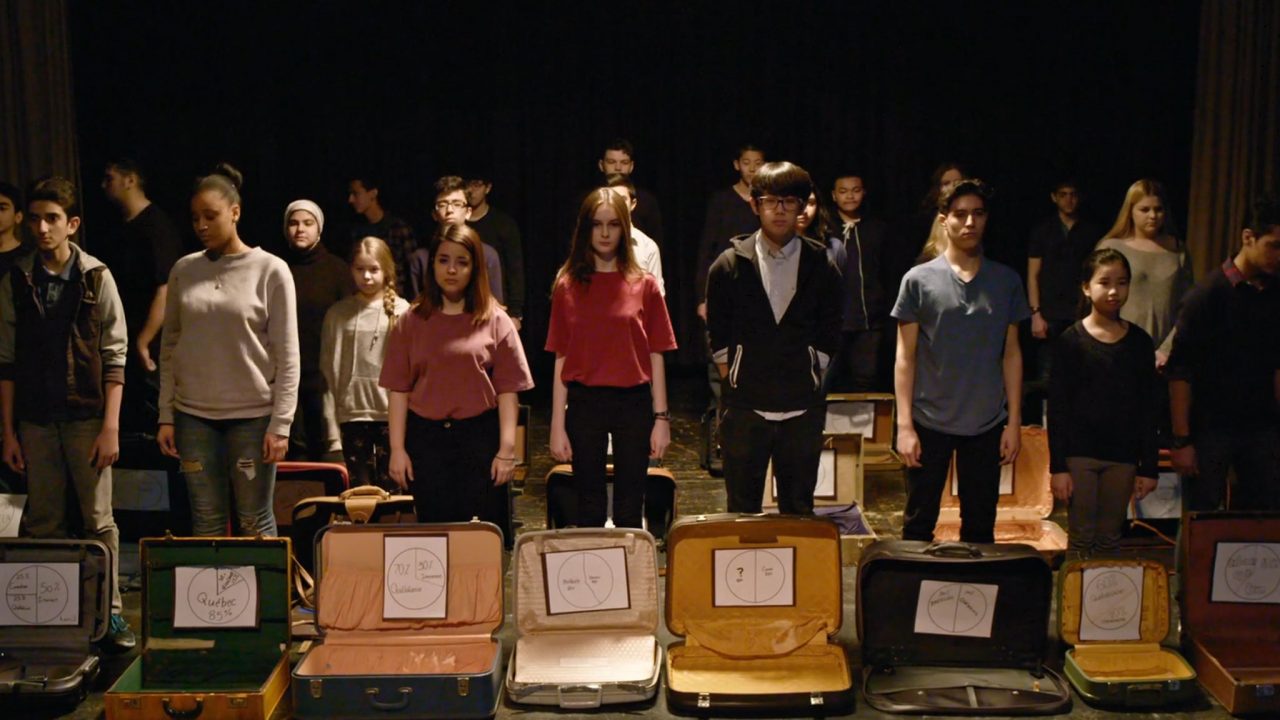
Mini-Lesson for Baggage
Mini-Lesson for Baggage
Mini-Lesson – Baggage
Theme: Cultural identity
Ages: 12–14
Baggage, Paul Tom, provided by the National Film Board of Canada
Keywords/Topics: Culture, Identity, Immigration, Québec, Theatre, Adolescence, Minorities
Guiding question : How do the concepts of identity and culture contribute to shaping you as a person?
Summary : Baggage features a group of teenagers who’ve just arrived in Canada. These youth attend a high school in Quebec and feel a sense of attachment both to their country of origin and their new country, Canada. Through the medium of theatre, they express their love for their culture and native country, as well as for their new lives in Canada.
Activity 1) Personal reflection
Watch the full clip by logging onto CAMPUS using the timecode: 3:00-11:11
Packing your suitcase
The teens featured in the documentary left everything behind to come and live in Canada. This past is now an integral part of their identity. Have you ever thought about your own identity?
Close your eyes and imagine that tomorrow, your parents announce that you’ll be moving to a new country, and that you can only bring one suitcase with you. Your suitcase will no doubt contain objects that define you as a person. Now imagine that it can only hold five items and five souvenirs. What would they be?
Before packing your suitcase, make a list of 10 nouns or adjectives that represent you best. You can ask your friends, family, or teachers for help. What words best define you?
Now, like the students in the film, pack your suitcase. Prepare a short presentation explaining who you are and describing the five items and five souvenirs you would put in your suitcase.
Go Deeper
Write a letter to a childhood friend or a family member whom you haven’t seen for a long time. In the letter, talk about the person you used to be and the person you’ve become. Practise reading your letter aloud to make sure it conveys the tone and emotions you want it to. Create a two-minute video entitled Who I Am and Where I Came From.
Record yourself reading your letter, then edit a short video that includes your audio recording, photographs, texts, or other visuals that help convey your letter’s meaning.
Activity 2) Podcast
Watch the full clip by logging onto CAMPUS using the timecode: 33:51-37:40
My school’s cultural profile
Baggage features a multi-cultural school. The theatre class includes new arrivals from all around the world who faced huge changes in coming to Canada.
A school is a cultural space that brings together many different individuals. Take a look at your school’s cultural profile. Your examination might consider the following points:
- cultural differences within the school;
- the socio-economic context of the school and surrounding area;
- the various cultural events organized in the school;
- the connections between the school’s culture and the community;
- the school’s strengths and weaknesses in terms of culture.
Compare your research with that of a classmate. Have you made similar observations and obtained similar results? Record a 3–5-minute podcast to explore your perspective of your school’s culture. The podcast should also talk about the differences you noted between your results and those of your classmates.
Go Deeper
Among all the cultures represented in your school, which do you know the least about? To learn more about that culture, arrange an interview with a student or staff member who identifies with the culture. Prepare five to eight key questions you’d like to ask the person to learn more about the culture. Record the interview so you can share it with other students in the class.
Activity 3) Infographic
Watch the full clip by logging onto CAMPUS using the timecode: 38:57-44:02
Being uprooted / Putting down roots
This excerpt of Baggage features a number of students singing “Happy Birthday” in their language of origin and questioning themselves about their new identity as Canadian immigrants.
Identity is a set of beliefs, traditions, and qualities that make you the person you are.
In small groups, draw up a portrait of Canada’s identity, or the identity of your province. You might discuss:
- its history;
- its traditions;
- its ancestral or official languages;
- its arts and culture (dance, music, etc.);
- its special characteristics (traditional dress, food, etc.);
- its customs.
Go Deeper
What are the similarities and differences between Canadian culture and other cultures? Choose a culture and create a portrait of it. Create an infographic comparing and contrasting Canadian culture to another culture from anywhere in the world.
Pour lire cet article en français, cliquez ici.
Discover more Mini-Lessons | Watch educational films on NFB Education | Watch educational playlists on NFB Education | Follow NFB Education on Facebook | Follow NFB Education on Pinterest | Subscribe to the NFB Education Newsletter



